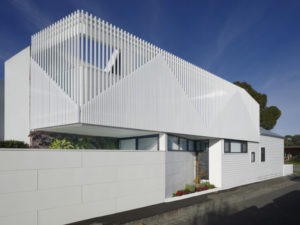Project Description
The plot is located within the context of a characteristic coastal neighbourhood in the dunes. The main typology here consists of detached houses. There are still a few typical fishermen’s cottages from the beginning of the last century left.
The usage of the house determined the design as a guiding principle. The ground floor was conceived as an open space comprising the entrance, garage, bathroom and a polyvalent space, also used as storage space and as accommodation space for visiting children or grandchildren. Sliding windows right up to the ceiling and Venetian blinds, which can be opened, allow optimal enjoyment of the garden from indoors. The first floor affords stunning views and a covered patio completes the holiday feeling. This floor comprises an open living space at roof height adjacent to the patio, a kitchen, bedroom and bathroom.
In terms of integration into the environment, the duality of use is reflected in the materials used for the house, which refer to the typology of the fishermen’s cottages, with whitewashed stonework, a black tarred base and a sloping, red-tiled roof. All around the base on the ground floor there are semi-transparent Venetian blinds that can be opened, while the first floor was built using white architectural concrete (formed with sandblasted pine planks) and has a sloping red-tiled roof.
When the house is not occupied, the semi-transparent shutters are closed and the house forms a clearly delineated volume. Towards the street the plot is secluded by deciduous hedges, so that only the white upper floor is visible from the public area.
This ‘summer house’ has an extremely functional design. The particularly original concept of this house provides its residents the pleasure of moments of relaxation and togetherness with the family, while sufficient privacy is also ensured. The design is also a contemporary interpretation of the characteristic fishermen’s cottages in the coastal surroundings.






























